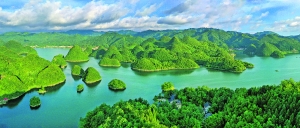Guiyang, Guian unfold ecological picture in recent years

Baihua Lake in Guiyang [Photo/VCG]
Guiyang and Guian New Area in Southwest China's Guizhou province are known for their beautiful environment.
Environmental improvement in past five years
Guiyang and Guian have successively built 660 parks of various types – including forest parks, wetland parks, mountain parks, city parks, and community parks.
Over the past five years, the forest coverage rate has increased to 55 percent, while the air quality rate has increased to 98.9 percent. The water quality of nationally-controlled and provincially-controlled river sections and the water quality compliance rate of centralized drinking water sources above county level have remained stable at 100 percent.
River management
Guiyang and Guian have built 32 new sewage treatment plants, with a daily sewage treatment capacity of 2.28 million metric tons and an urban sewage treatment rate of over 98.5 percent. Guiyang and Guian have also carried out a traceability analysis on 2,388 river outlets in the city.
The city's black and odorous water bodies have been extensively cleaned, and the Nanming River now boasts clear water and green banks.
"The water has become much cleaner," said a villager who has lived by the Nanming River since she was a child, "The environment is so good now. It's very pleasant to walk along the river."
Extracting value from ecological resources
A company in Guiyang recently conducted an online targeted carbon purchase of 48,300 trees in five impoverished villages worth a total of 142,800 yuan ($21,964).
All income from these carbon purchases goes into the hands of farmers, and the 109 poor households in the five villages have seen an average income increase of more than 1,300 yuan.
Agriculture has become greener, as the under-forest economic utilization area has reached 1.22 million mu (81,667 hectares), with an output value of 10.76 billion yuan.
Industrial transformation has also become greener, as a large number of demonstration projects have emerged in the fields of medicine, equipment manufacturing, and new building materials. The green economy now makes up 47 percent of regional GDP.
Presented by China Daily.
黔ICP备05001922号-3
